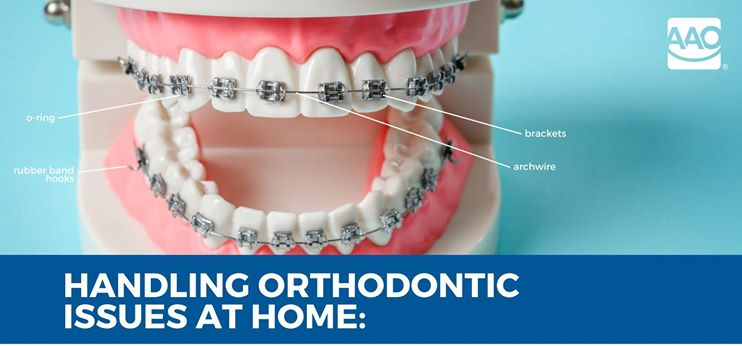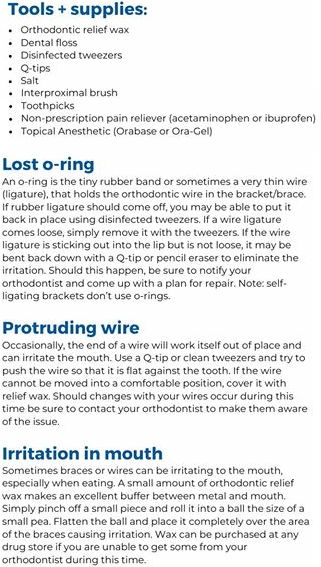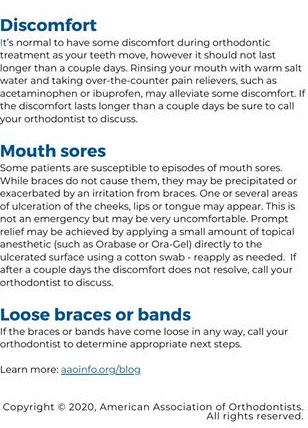
Home Care



Brushing
You will notice that it is much harder to keep your teeth clean with braces. Food compacts in the brackets and between your teeth, and can only be removed by brushing and flossing. If plaque remains on the teeth for any length of time, it will leave a permanent white scar on the surface. Brushing after meals should become part of your daily schedule. Use a soft toothbrush with firm pressure and brush at a 45-degree angle to the tooth; brush in small circles above and below the brackets. Click here for visual instructions. Your toothbrush will wear out faster because of your appliances, so be sure to replace it whenever the bristles start to fray. A waterpik can be a useful addition but it cannot remove the sticky plaque that adheres to the teeth. Interplak toothbrushes are great. Flossing is important and should be done everyday. The floss threaders are reusable.
Eating Habits
Please do not eat hard foods: nuts, ice, crisp taco shells, whole apples and carrots (cut them into pieces first), hard French bread crust and rolls, spareribs, corn on the cob (cut the corn off the cob before eating), and popcorn! These foods risk breaking brackets and wires. Also beware of nail biting and pen or pencil chewing habits, since these can damage your braces. Do not eat sticky foods: taffy, caramels, bubble gum, or sticky candy of any sort. A small piece of sugarless gum occasionally is acceptable. Use common sense about most foods.
ABSOLUTELY NO
- Gum
- Caramels
- Sugar Daddies
- Starbursts
- Caramel Apples
- Sugar Babies
- Licorice
- Toffee
- Tootsie Rolls
- Now & Laters
EAT WITH CAUTION OR CUT UP
- Hard Foods
- Nuts
- Popcorn
- Bagels
- Apples
- Corn on the Cob
- Pizza Crusts
- Carrots (uncooked)
- Doritos
- Pretzels
EAT MUCH LESS
- Candy
- Ice Cream
- Cake, Cookies
- Pie
- Foods with Sugar
DRINK MUCH LESS
- Pop/Soda
- Drinks with Sugar
Oral Hygiene
Daily oral hygiene is critical to maintaining healthy teeth and gums during orthodontic treatment. You will notice that it requires more effort to keep your teeth clean with orthodontic appliances in place. Food may become trapped around your brackets and between your teeth and can only be removed by brushing and flossing. Plaque remaining on the teeth due to poor hygiene may cause swelling of the gums, cavities, and white scars on the tooth surface.
Brushing after meals should become part of your daily oral hygiene. Use a soft toothbrush with firm pressure and brush at a 45-degree angle to the tooth; brush in small circles above and below the brackets. Your toothbrush will wear out more rapidly because of your appliances, so be sure to replace it when the bristles start to fray. A mechanical or ultrasonic toothbrush are popular options with many of our patients and can be used effectively without damaging your orthodontic appliances. Flossing is critical for cleaning between the teeth and should be done every day. Many flossing aids have been designed for assistance while flossing with braces. We will review hygiene with you at your regular visits and provide you with tips on taking care of your teeth while in orthodontic treatment. Finally, every patient with cemented appliances should be using a daily prescription strength fluoride rinse.
- Brush after every meal.
- Use a toothbrush with a small amount of toothpaste.
- Use circular, vibrating motions around the gumline for about 10 seconds on each tooth.
- Brush every tooth slowly.
- Brush the lower teeth up and the upper teeth down. Also brush your tongue and the roof of your mouth.
- Floss nightly after brushing to remove the plaque missed by brushing.
- Carefully pull waxed floss between wire and braces.
- Floss carefully around the braces.
- Floss carefully around the gum area.
- Floss around each tooth.
First Aid
If a wire causes irritation, push the wire away from the area using the eraser end of a pencil or a Q-tip. If the wire cannot be tucked away, cover the end of the wire with a small piece of wax, a cotton ball, or a piece of sugarless gum, until you can come into the office for an adjustment.
If the main wire has come out of the tube or pipe on your back molar tooth, attempt to reinsert the wire with a pair of needle nosed pliers or tweezers. If the wire is not sticking you, place a piece of wax over the area. If the wire is sticking you and wax does not help, the wire can be cut with a small wire cutter or toenail clipper close to the back of the last brace. This is a last resort if professional help is unavailable.
In case a rubber spacer falls out, take two pieces of dental floss and insert them through the spacer. Pull on both pieces of floss to stretch the spacer, then slide the spacer back and forth between the two teeth where it belongs. Once the bottom half of the spacer slips under the tight spot between the teeth, release and remove the floss and the spacer will fit back properly.
If a bracket becomes loose, it usually remains connected to the main wire by a little rubber colored ring. Eyebrow tweezers can be used to reposition the brace if it flips around the wire and becomes a source of irritation. Call our office and inform us of your situation.
If a piece of your braces breaks, save the piece and call our office to schedule a repair visit.
Remain calm if you swallow a piece of your appliance. This will usually go either into the stomach and pass out of the body in a bowel movement. However, if difficulty breathing is experienced, you should seek immediate medical attention. X-rays will be taken to determine the location of the swallowed piece.
If a retainer cracks, remove the retainer from your mouth and bring all the pieces to our office for professional repair.
Take Aspirin, Tylenol or Ibuprofen (unless allergic) if your teeth are sore after a monthly visit.
Rinsing your mouth with a cup of warm water and teaspoon of salt can also be soothing. If your teeth get sore suddenly in the middle of the month, give us a call because it is unusual for the teeth to get sore several weeks after your last office visit.
If food becomes stuck between your teeth, use dental floss or a proxy brush to dislodge the food.
If you cut your gums, tongue or the inside of your cheek, apply finger pressure to the bleeding site for several minutes. If the bleeding won't clot, call your orthodontist or primary care-family dentist.